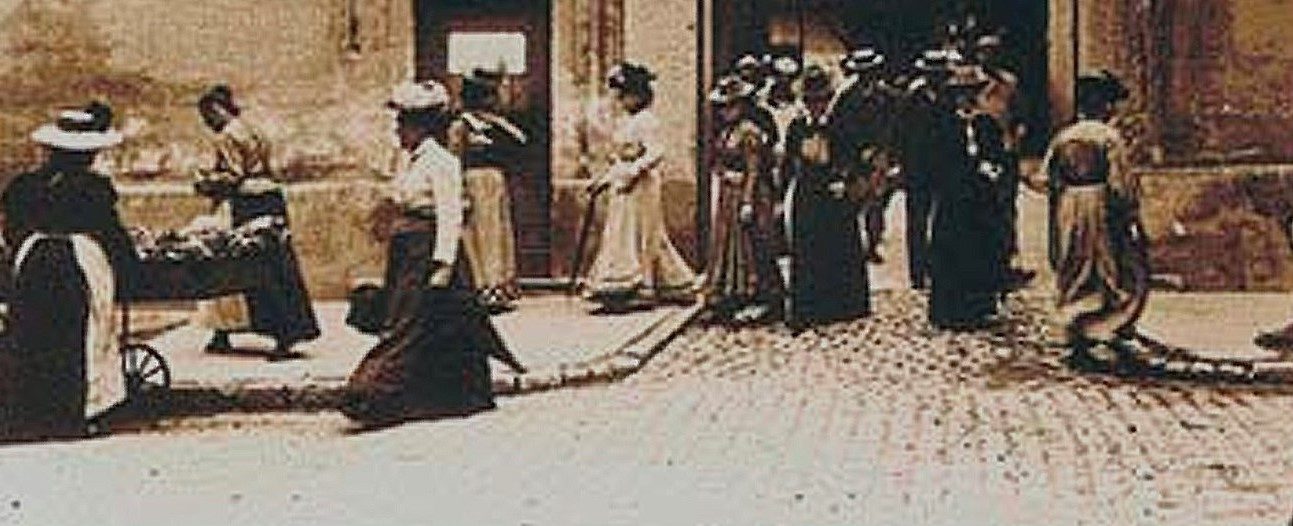Japan, 1957
Directed by Kurosawa Akira
With Mifune Toshirô (Washizu Taketoki), Yamasa Isuzu (Washizu Asaji), Chiaki Minoru (Miki Yoshiaki)

This is a samurai film with a foreign accent as the plot of “Kumonosu-jô – Throne of Blood” is conspicuously based on William Shakespeare’s “Macbeth”. Washizu is a mediaeval military chief who successfully helps his king keep his power by quashing military rebels; Miki is his companion. Both are summoned to the king’s fortress but get lost in the nearby forest where a spirit predicts that, after their promotions due the next night, Washizu will later become the king and Miki’s son will be his successor. Like the Elizabethan play, the wife of the main character talks her man into betraying his lord as well as his ally. First, Washizu murders the king and falsely accuses another warrior. Once recognized as the legitimate ruler, he ends up getting rid of Miki. But he cannot prevent a rebellion, led by the king’s son and Miki’s son among others, to attack his territory. He seeks the advice of the forest’s spirit; instead, four spirts suggest there is little danger and whip up his rage and passion for power. Unfortunately, his wife becomes mad and the enemies prove bolder and smarter than he imagined; terrified and rattled, his men kill him.
A conversation between Miki and his son, just before a Washizu henchman sets out to murder them, points to the key question raised by the story so far: unlike the father, the son casts doubt on the validity of the prophecy and wonders whether the men aren’t simply creating the facts to fulfill it. Told of their future, aren’t they bent on doing whatever it takes to accord reality and divination? An opposite case can be made: can’t they be tempted to prevent some events to happen if the effort suits their ambitions?
To these questions, Washizu Asaji, the Lady Macbeth of the movie, gives a radical answer: rush headlong. She is keen on troubling her husband’s conscience and shows no qualms for it; she has a knack for expressing misgivings and speculations that slowly shake the loyal, pragmatic mind her husband has most of the time; for her time is the essence and she drives him to precipitate things. Washizu gives in, though grudgingly and with no satisfaction. His face lively expresses his torment, his grunts emphasize his malaise, and his gestures grow stiffer as the situation gets more uncomfortable for his ambitions and beliefs.
Mifune Toshirô plays the part with much care to express emotions but the end result sounds rather outrageous; the interplay with other actors feels awkward; Washizi’s death is a long-drawn affair as arrows endlessly pierce his armor to little effect since he stumbled without falling, his eyes bulging to grotesque proportions. The character may be great but the actor is hamming sometimes. As for Yamasa Isuzu, her character sounds rather contrived in her supposed manipulative talent. She suddenly vanishes of the story only to reappear at the last minute to make the expected performance of washing her hands clean even if blood is only in her imagination. In fact, unlike her English counterpart, Lady Asaji talks less and is less present; it is harder to appreciate the insidious and increasing influence she exerts on her husband, making the whole story more abrupt.
Then, it isn’t so much a tidy adaptation than a visual rendering of a famous drama. A male choir, singing in a martial tone, gives a sobering comment on men’s vanity as the camera focuses on ruins. Fog then wraps them and when it dissipates a fortress appears: the first sequence carries us right into the topic of fate and fatal adventures with a striking use of nature and man-made elements; the same images and sounds come back at the end of the story, smartly framing it and quietly emphasizing the message. The fog sweeps back the screen when Miki and Washizu try to find their way out the forest, still unnerved by the spirit’s prophecies. The whole sequence is amazingly dynamic and plunges us into the dark mystery lying at the heart of the place and of the narrative.
If a constant visual imagination and vigor apply to landscapes, what happens to the characters is strongly conveyed by the geometric and photographic exploration of the palaces (first Washizu’s then the royal fortress). Washizu often stands on the border or at the center of the frame and the camera deftly tracks how under pressure from his wife or from the events his body errs and ends up in a corner. Admirable is the moment when Asaji fades in a dark corridor and emerges back with a jug filled with poisoned sake so as to make soldiers sleep and make it easier to murder the king.
By the way, though the narrative of “Kumonosu-jô – Throne of Blood” is rich in violent and bloody events, nothing is shown: battles are described by heralds at the beginning, blood stains are the only indication of the king’s death, and a bundle turns out to be Miki’s severed head. The reality of this violence is in no way diminished but its tragedy underlined. Only the death of Washizu is displayed, in the most excessive fashion – perhaps the solemn verdict on a man who has played with fate and violence, egged on by his wife and his vanity to believe and make believe in a future that none of us can really hope to master.

